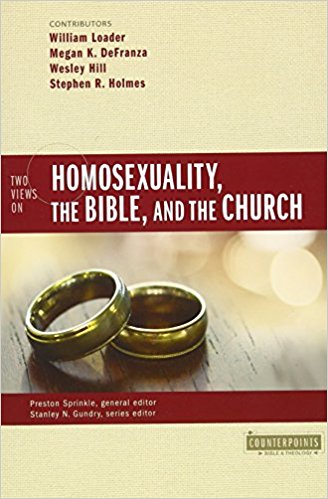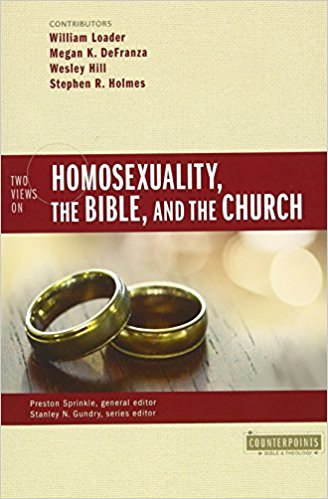Two Views on Homosexuality, the Bible, and the Church

A Denver Journal Book Review by Denver Seminary Instructor of NT Greek Elodie Ballantine Emig

Sprinkle, Preston, ed. Two Views on Homosexuality, the Bible and the Church. Grand Rapids: Zondervan, 2016. $16.99. Paperback, 237 pp. ISBN 9780310528630.
To cover the topic of same-sex attraction, with or without the Bible and the Church, in a couple of hundred pages is a tall order. Still, this entry in the Counterpoints series has much to commend it. Variations on the traditional and affirming views, both of which can be nuanced in a wide range of ways, are clearly articulated, critiqued, and defended. The four contributors (William Loader, Megan DeFranza, Wesley Hill, and Stephen Holmes) and the editor (Preston Sprinkle) succeed in discussing a volatile issue with mutual respect and charity. The first three briefly exegete relevant Old and New Testament passages, while Holmes offers theological reflections on yet briefer treatments of some biblical texts. All four carefully apply their interpretations of Scripture. There is engaging interaction among the writers in both their responses to one another and the rejoinders of each. Sprinkle wraps up with a review of key points made in the essays and his own sense of how the discussion of Christian sexuality might continue. If one is looking for a short volume written by people who honor the Bible as God’s Word and yet come to different conclusions regarding the rightness of same-sex behavior, Two Views … is a fine place to start.
Loader’s essay, the first in the book, was the most surprising to me. I did not expect one “widely regarded as the foremost scholar on sexuality in ancient Judaism and Christianity” (p. 13) to make the case that Paul’s view of human sexuality was significantly, if understandably given his temporal situation, errant. According to Louder, “Paul appears to assume, like other Jews whose discussions have survived, that all people are heterosexual” (p. 42). I hope it is not too much of an oversimplification to summarize his argument as: Paul thought that God made all people heterosexual; Paul was incorrect in this instance, since some people are “genuinely gay” (p. 45); therefore, Christians are free, even compelled by justice, to revise our conception of marriage. It seems to me that there is some logical distance between saying that the first chapter of Romans affirms God’s design for human sexuality as plain (and heterosexual) in his creation of humanity as male and female and saying that it indicates all people are heterosexual. Moreover, as Hill points out in his response to Louder, the idea that Paul thought all people are heterosexual is anachronistic. Paul “did not think of a normative ‘sexual orientation’ because he did not think at all in terms of sexual orientations in the modern sense of that term” (p. 56). Holmes goes further, “Paul no doubt knew directly of Roman aristocrats who habitually raped their slaves, both male and female. To say he regarded them as ‘heterosexual’ is to say that he regarded the rape of female slaves as somehow more acceptable, or at least more natural, than the rape of male slaves. I suppose Paul would have regarded both with equal horror” (p. 62).
Louder also takes the unpopular stand that Paul considers same-sex orientation, not just same-sex sexual activity, to be unnatural and sinful. “Paul does not explain same-sex attraction as a disability resulting from Adam’s fall, but as something that ought not to be, a state of mind resulting from a perverted understanding of God” (p. 44). My problems with Louder’s reading of Romans are numerous, but here I will limit myself to asking related questions: Did not Adam’s fall stem from a perverted understanding of God’s goodness? In other words, is there a meaningful distinction between the results of Adam’s fall and those of the race’s perverted understanding of God? In Holmes’s words, “In Christian theology, ideas of the fall and original sin teach us that all our desires are in some sense wrongly directed … East of Eden, every actual desire is warped, including all heterosexual desire” (p.63).
The second essay traces DeFranza’s journey to becoming same-sex affirmative along a bioethical path. The existence of intersex persons leads her to conclude that Genesis and the creation of male and female are truly just the beginning of the human story. Given more of that story, she “began to see space opening up between these two, between male and female—space for others” (p. 71). Because human sexuality is more complicated and varied than Genesis might lead us to believe, we need to make room for those on the sexual/gender margins. Adam and Eve may give us a picture of the majority, but “what is not obvious is that this statistical majority should be interpreted as the exclusive moral model” for human sexual behavior (p. 98). DeFranza appears to be among a growing number of evangelicals who understand gender diversity beyond male and female as a sign, not of the fall, but of God’s intentional creativity. So too, she states, “Contemporary Christian marriage is not ‘biblical marriage’ of the Old or New Testament” (P.92). Marriage has evolved through two testaments and still has room to grow, she opines.
With Hill, I applaud DeFranza’s compassion for sexual minorities and her desire to explore how their “experiences can be surrendered to God in discipleship” (p.108). And with Hill (and Holmes) I think she misunderstands how the fall has affected both gender and marriage. “God’s creation of ‘male and female’ is to be understood as normative in a way that our current access to it in actual human life is not” (pp. 109-110). He reminds us that there is a reason that Genesis 1 and 2 precede the story of the fall: they give us a picture of how God intended humans to be. Additionally, Holmes “suggest[s] that the theological reality of marriage is in fact fairly stable … We need to distinguish … between … [it] and its ever-changing cultural trappings” (p. 115).
Hill, in the third, which is also the first traditional, essay, makes it clear that he writes as Christian, celibate, same-sex attracted man (possibly not in that order). He ably and succinctly summarizes his own variation on Augustine’s theology of marriage: “Marriage is a bond of male and female, ordered to procreation, sealed in faithful union, and signifying Christ’s love for the church” (p. 131). In his discussion of “a Christian theology of homosexuality” (pp. 139-144), he also interacts with Robert Song’s argument that for those who are ‘in Christ,’ procreation is no longer a necessary good of marriage. Death has been defeated, so Christians can concentrate on increasing the population of the Kingdom of Heaven, rather than on securing their own earthly heritages. I find Hill’s reaction to such hyper-realized eschatology to be apt: “Song can easily explain why Paul recommends celibacy in 1 Corinthians 7; I don’t see that he can so easily explain why Ephesians is so interested in marriage and children as part and parcel of a Christian life” (p. 142).
In his last section, Hill proposes “spiritual friendship” as a life-giving option for same-sex attracted Christians. He rightly, in my opinion, finds Song’s and similar pleas for the Church to celebrate same-sex marriages to stem from a sub-Christian understanding of and vision for intimacy. He queries, “Is our longing to bless our gay and lesbian friends with marriage a sign that we have located permanent, faithful intimacy more or less exclusively in marriage, in such a way that we can no longer imagine it existing elsewhere?” (p. 144). Since I resonate with Hill more than with the others, I find at this point that I simply want to add my own question, “Don’t we need to return to more robust definitions and experiences of friendship than are currently available, especially through social media?”
Holmes, as noted above, takes a theological approach to the issue of same-sex attraction. He unpacks in detail how Augustine dealt with the “dual reality” of 1 Corinthians 7 and Ephesians, of the goodness of celibacy and of marriage. Augustine saw marriage as a discipline of self-sacrifice and self-giving and thus “properly named an ‘ascetic’ practice” (p. 172). Holmes then mentions two departures from the Augustinian view of marriage, contraception and remarriage after divorce as “pastoral accommodations,” rather than rejections (pp. 173-176). From these he turns to a very brief review of marriage through Church history with a focus on negative appraisals of same-sex marriage behavior. Of particular interest to me is his evaluation of a universal “right to marry” (p. 182). Our culture tells us that sexual expression is necessary to a healthy adult life; the Bible does not. It is instructive that the one perfect man ever to have lived never had sex (with no apologies to Nikos Kazantzakis). The truth in Holmes’s mind is that “our sexual desires are not in pressing need of being fulfilled; they are in pressing need of being mastered and reordered so that we may grow into Christlikeness. Marriage is a discipline for the latter, not a permission for the former” (p. 184). Yet, he is willing to ask whether there can be some kind of pastoral accommodation for same-sex marriages given the cultural realities of our times and to answer with “probably” rather than “NO!” (p. 193). “Churches that believe same-sex partnerships to be wrong might nonetheless find space within their life for people living in such partnerships out of pastoral concern” (p. 190).
Holmes admits that his essentially non-affirming stance flows from his acceptance of an Augustinian approach to marriage, which could be wrong. He quickly adds, “To overthrow an Augustinian theology of marriage, though, will require a new theology, equally carefully developed and equally biblically plausible, to be offered in its place” (p. 193). Both Louder and DeFranza call for a serious revision if not an overthrow. Louder states, “The reality then and now is that sexual engagement cannot be restricted to attempts to procreate” (pp. 196-197). DeFranza directs us to the desert fathers and mothers and maintains that “Augustine wrote to defend marriage as having intrinsic goods, even if these goods were not the ‘better’ of celibate religious life” (p. 201). While both of these points have merit, they do not require an acceptance of same-sex marriage. Whatever we conclude on that issue, I hope we do so carefully and share how and where we have landed with the “convicted civility” demonstrated in this book (p. 226, with thanks to Rich Mouw).
Elodie Ballantine Emig
Instructor of NT Greek
Denver Seminary
June, 2017
